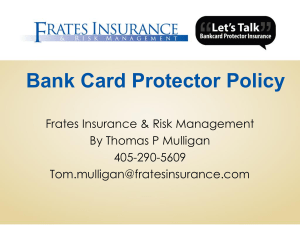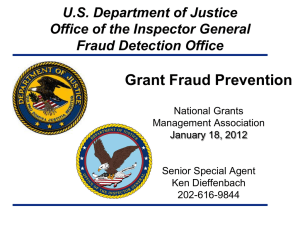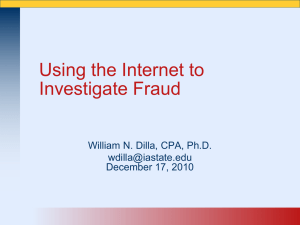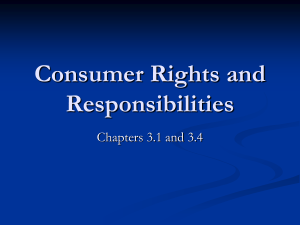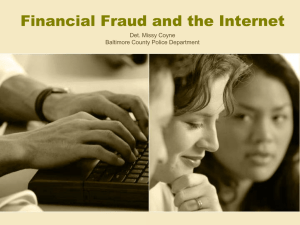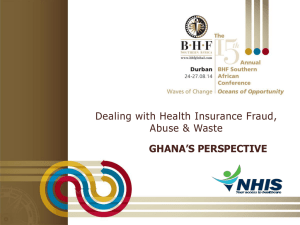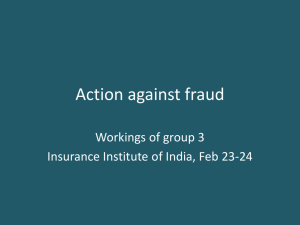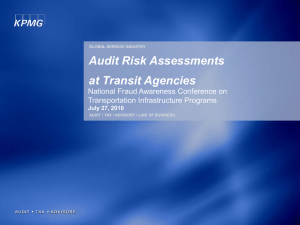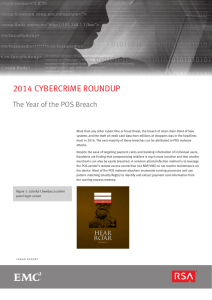slides
advertisement
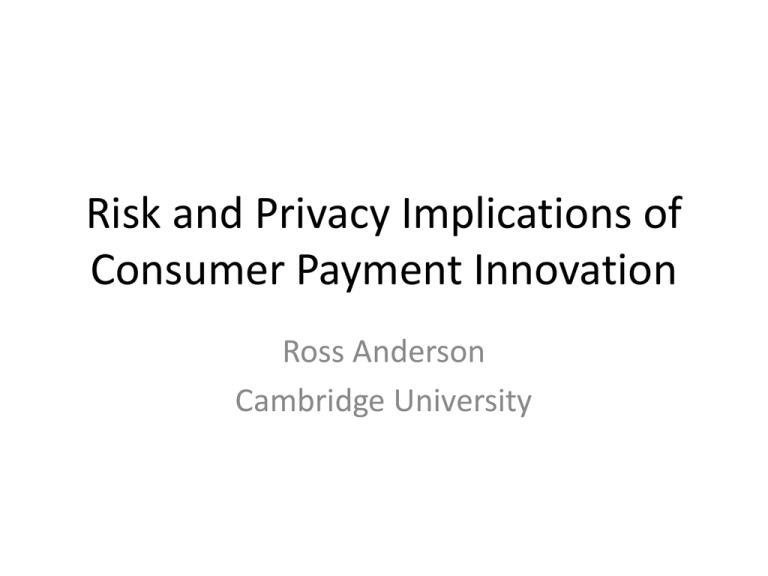
Risk and Privacy Implications of Consumer Payment Innovation Ross Anderson Cambridge University Overview • • • • • • • • Competition – Sofort, Pingit Background on payment service regulation Cyber-crime patterns and trends in 2012 Mobile payment trends Mobile wallets Carrier billing Remittance services, social, credit Ways forward for payment service regulators Buying a plane ticket (1) Buying a plane ticket (2) Buying a plane ticket (3) It’s fronting for this: Sofortüberweisung • Rapidly-growing low-cost payment service – Merchant website redirects to Sofort – Sofort asks for bank account # and tries to logon – Relays the authentication challenge to customer – Uses credit transfer to pay for purchase • Middleperson attack on online banking! • Fee 0.75% + 10c instead of 2.5% • Banks’ law case against Sofort failed after Federal competition authorities intervened Pingit • Barclays product for phone-based payment; mobile number as proxy for account number • Phase 1: Barclays customers only; peer-topeer payment limit £300 • Phase 2: any bank’s customer can use it, following a one-off direct-debit authorisation • Background: banks want to abolish cheques • Could mobile be a mould-breaker like Sofort? Possible roadblocks • Mobile payments are really successful in Kenya, Pakistan, South Africa… and bring significant social gains • In developed countries it hasn’t taken off! Mobile payment predictions of 1bn users, $1trn turnover “within five years” since 2002 • Innopay 2012 report: need speed, security, functionality • But it may actually be about cost… Possible roadblocks (2) • Consumer protection better on credit cards than PIN debit (discount 2.5% vs 1.5%) • If we move to phone / Sofort at 0.75% there will be pressure to cut this • Also, fraud is about 30 basis points online versus 5 face-to-face • Protection now good in USA, OK in Fi, Nl, bad in GB, Spain, Latvia – affects online confidence • Will Reg E / Reg Z be circumvented? Possible roadblocks (3) • The EU do-not-track directive is already causing grief to online businesses • Privacy tussles will get worse with mobile – cellsite location history is sensitive data • Controversy already: path.com, flurry.com • Also: interaction with malware • Now that the bad guys can steal money they are targeting smartphones (so far mostly dialers, SMS stealers, and mostly in China, but just wait!) Future regulation? • Payment regulation has always been dynamic – 130 years of tussles over forgery, cheque crossing, settlement, liability, interchange fees, … • Things are getting ever faster and more complex! • Ever more of the players are nonbanks – First Data, IBM, … – FICO, Experian, … – Nokia, Blackberry, Google, eBay, Microsoft, … • Governance is going to be hard Cyber-crime patterns • Cyber-crime now defined in EU as just about every bad thing done with IT! But four basic types – Traditional stuff like tax fraud and welfare fraud – Offences with rapidly changing modus operandi like card fraud – Novel offences like fake antivirus scams – Platform offences such as running botnets • As you work down the list, the indirect cost ratio (costs in anticipation and consequence versus direct losses) rises sharply from < 10-1 to > 102 – like the indirect costs of a mosquito bite Whither payment fraud? • Nilson 2010: card fraud $7.6bn (US $3.6bn) • Our 2011 figures: card fraud costs $9.2bn direct and $2.4bn indirect • Online bank fraud costs $690m direct, $1bn indirect (and rising sharply thanks to Zeus) • Opportunity costs are greater still (maybe $30bn) • The move online, and the move to mobile, may increase fraud losses (even double them) • ‘Fraud Inc’ might have a market cap over $100bn • But don’t panic: this may still increase welfare Existing mobile payment systems • Biggest success in less developed countries • Kenya, South Africa: PIN encrypted in the SIM card, transaction via traditional bank network • Others send PINs in the clear via USSD, and take the risk • Peer-to-peer payments being built out into peer-to-agent and even agent-to-agent • Growing ecosystem includes access to government services and much else Existing mobile payment systems (2) • NFC payments started in Japan 10 years ago • 2011: launch of the Google Wallet (an app that does tap-and-pay via an SE/ NFC chip) • 2012: NFC payments being promoted for the Olympics; TV fear about possible card cloning • Technical risks include easier relay attacks and a series of engineering problems with EMV • Governance problems include reprovisioning Existing mobile payment systems (3) • Carrier billing (e.g. premium rate SMS) in pain • Android malware leading to chargebacks in excess of 20% in some countries / sectors • We’ve been here before (modem diallers) • Fixes: – remove bad apps quickly from app stores – instrument the network to spot malware quickly – delay payment to suppliers • Industry hopes the SE will fix this, but PBX fraud is also rising very rapidly Other sources of disruption • Low-cost remittance services like oanda.com • Off-the-wall entrants like Bitcoin • Facebook credits (but has a 30% merchant discount, like carrier billing!) • P2P such as zashpay and popmoney • Innovations in credit, from ‘crowd’ (zopa.com, smaba.de) to ‘surveillance’ (Telrock) • Merchant-side innovation such as Tesco Bank ‘Bad’ payment systems • Cyber-crooks want irrevocable payments (watch the UK’s Faster Payments scheme!) • eGold got raided: Western Union now handles most of the cashout from core cybercrime • Webmoney is used internally by crooks • Porn payments: two-sided adverse selection • High-yield investment programs (‘postmodern Ponzi schemes’) have a number of PSPs Outcomes best avoided • Could catastrophic fraud close a channel? • Pessimist: once cash, keys and tokens are all phone apps, we have a huge target and an intractable governance problem • Optimist: if an attack’s big enough attack to disrupt, where do you send all the money? • Alternative bad outcome: pervasive carding that undermines confidence and imposes large opportunity costs on economy What might governments do? • See our paper ‘Security Economics and the Single Market’, ENISA, 2008 • Better stats on both fraud and malware, start to fix liability rules, require network-attached consumer electronics to be secure by default, better police cooperation … • Many of these are now being worked on (e.g. Eurozone fraud stats from this year) • What should the Fed’s priority be? What might the Fed do? • Esther: the Fed must be prepared for crisis! • The Fed should set up a Fraud Analysis Centre to collect information from banks, online service companies, PSPs, CRAs and others • Someone has to process data to get actionable intelligence (NCFTA? NACHA?) But someone also needs to track the big picture – a role for the Fed • If the Fed wants to do a P2P payment service it should first study what goes wrong … Next steps • Workshop on the Economics of Information Security, Berlin, June 2012 • Our web page on bank fraud: http://www.cl.cam.ac.uk/~rja14/banksec.html • Other current research: – Econometrics of online crime – Mobile malware – Next-generation platform components NATO meeting October 10 2011
